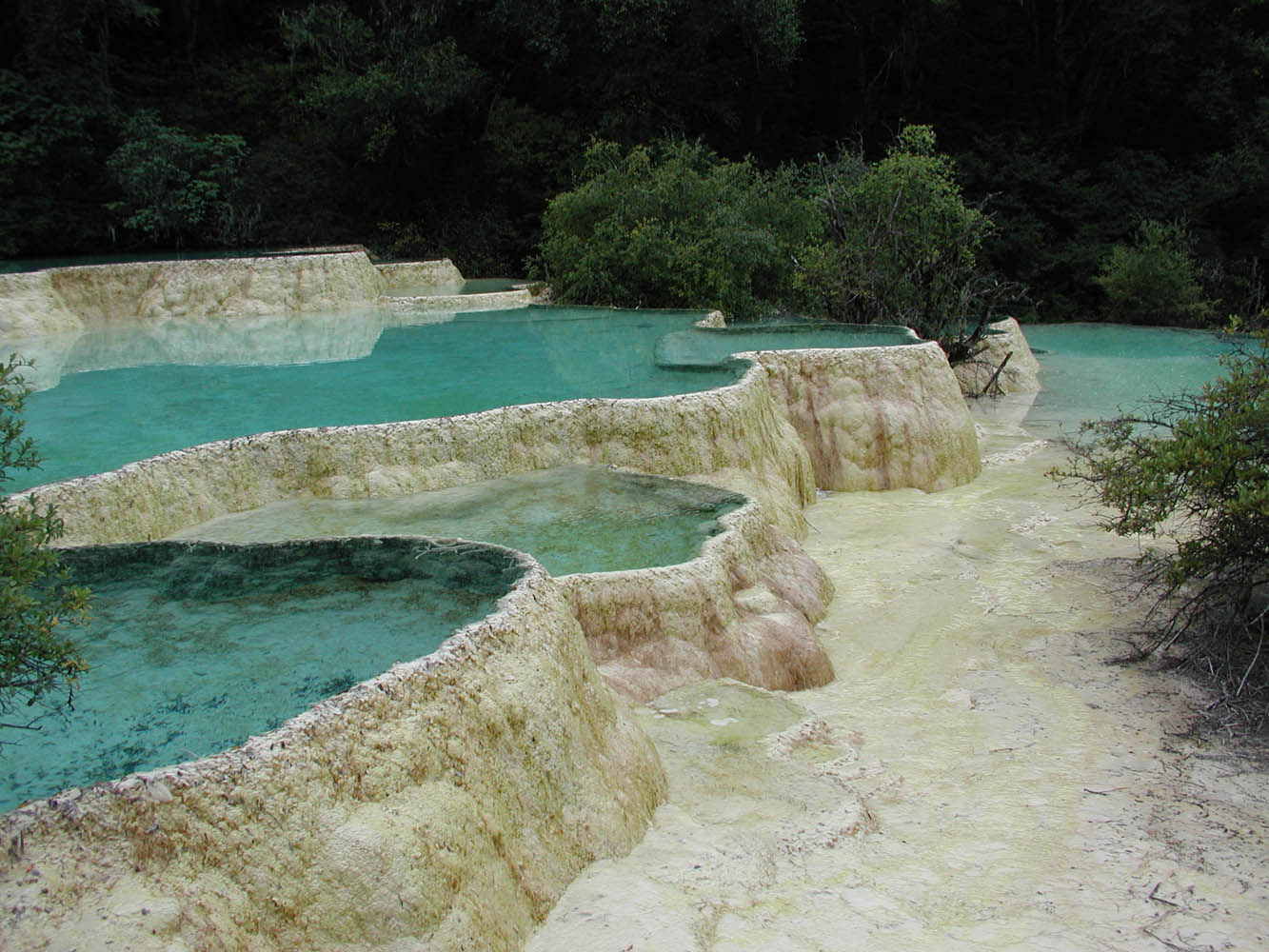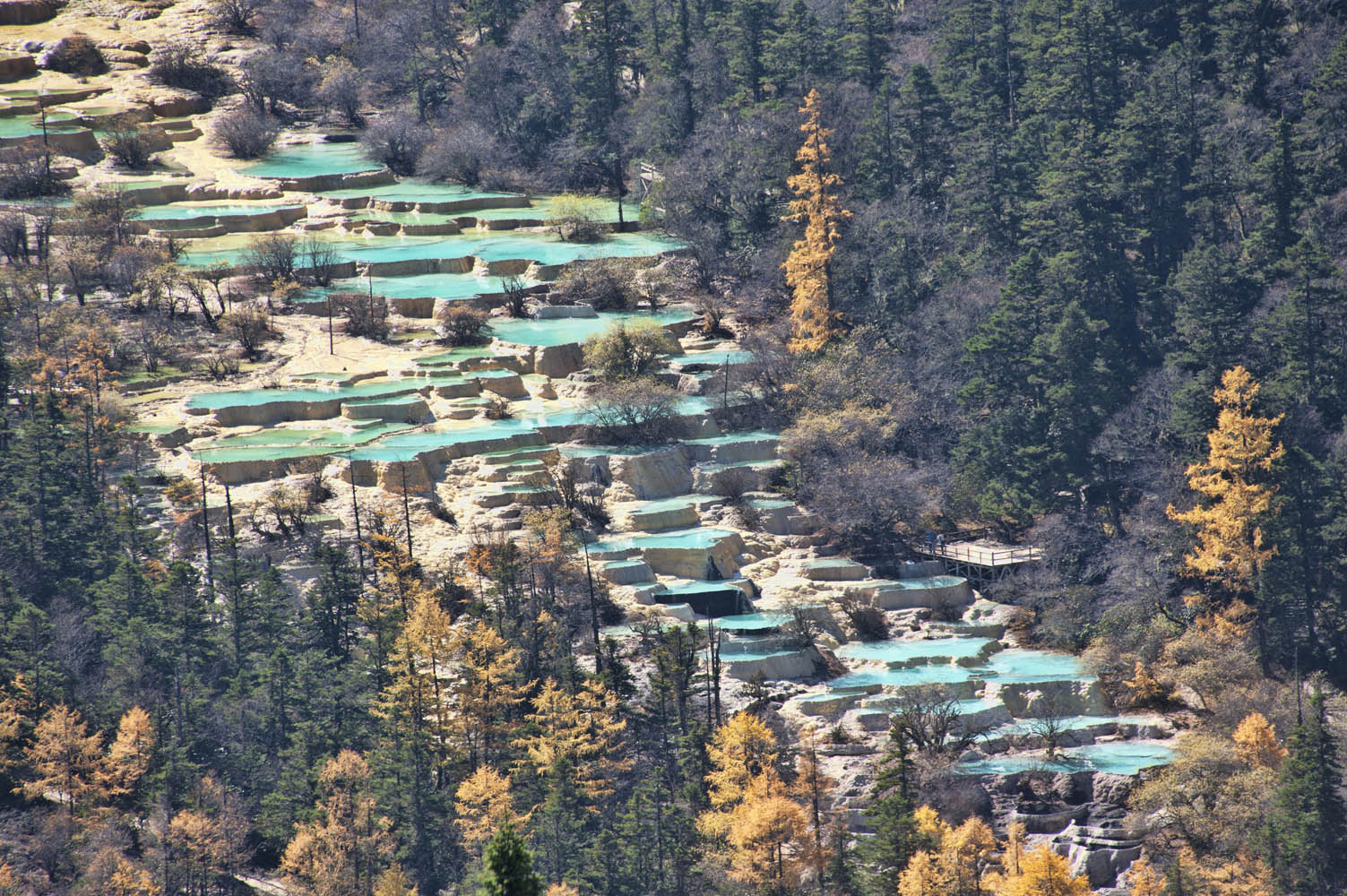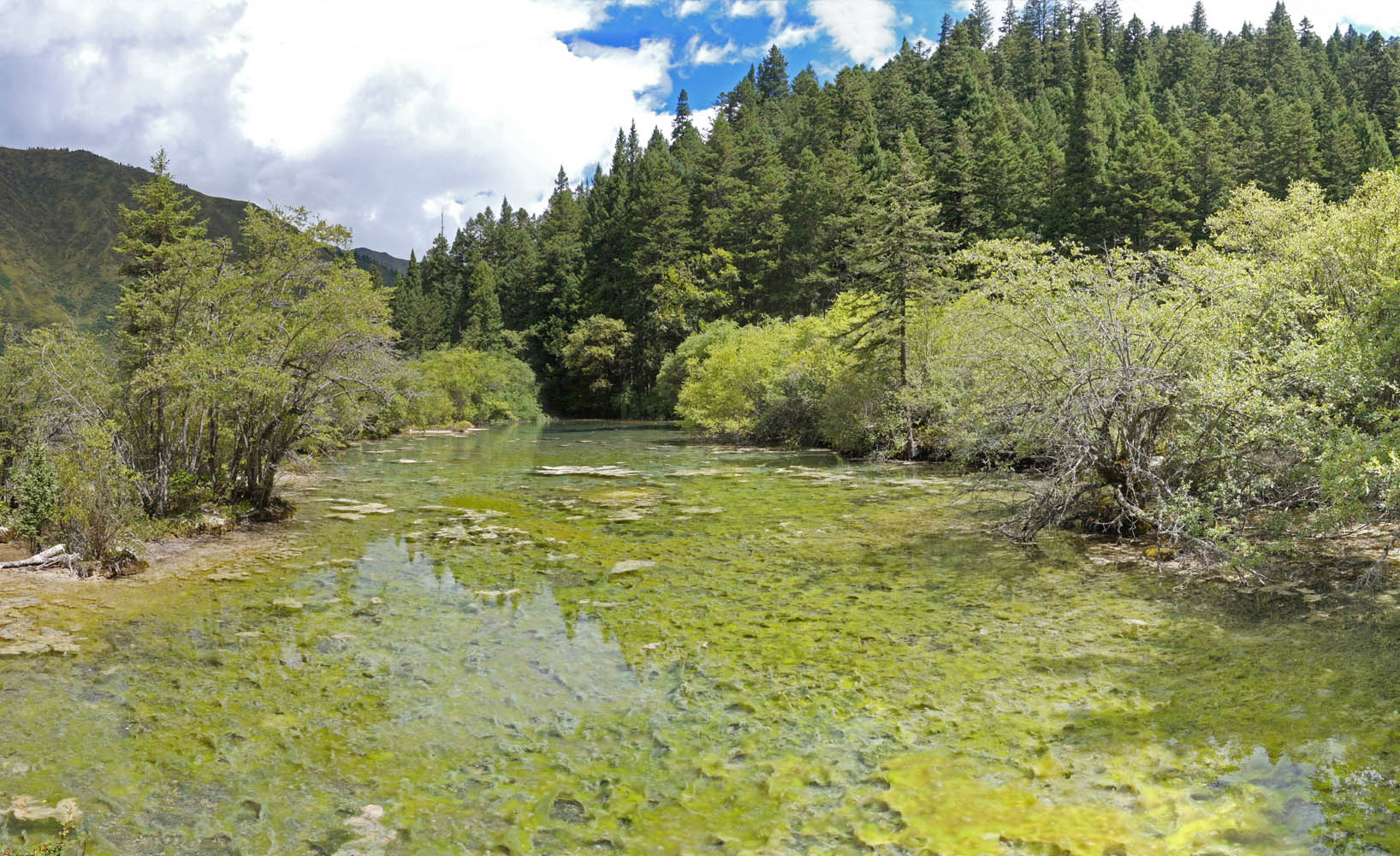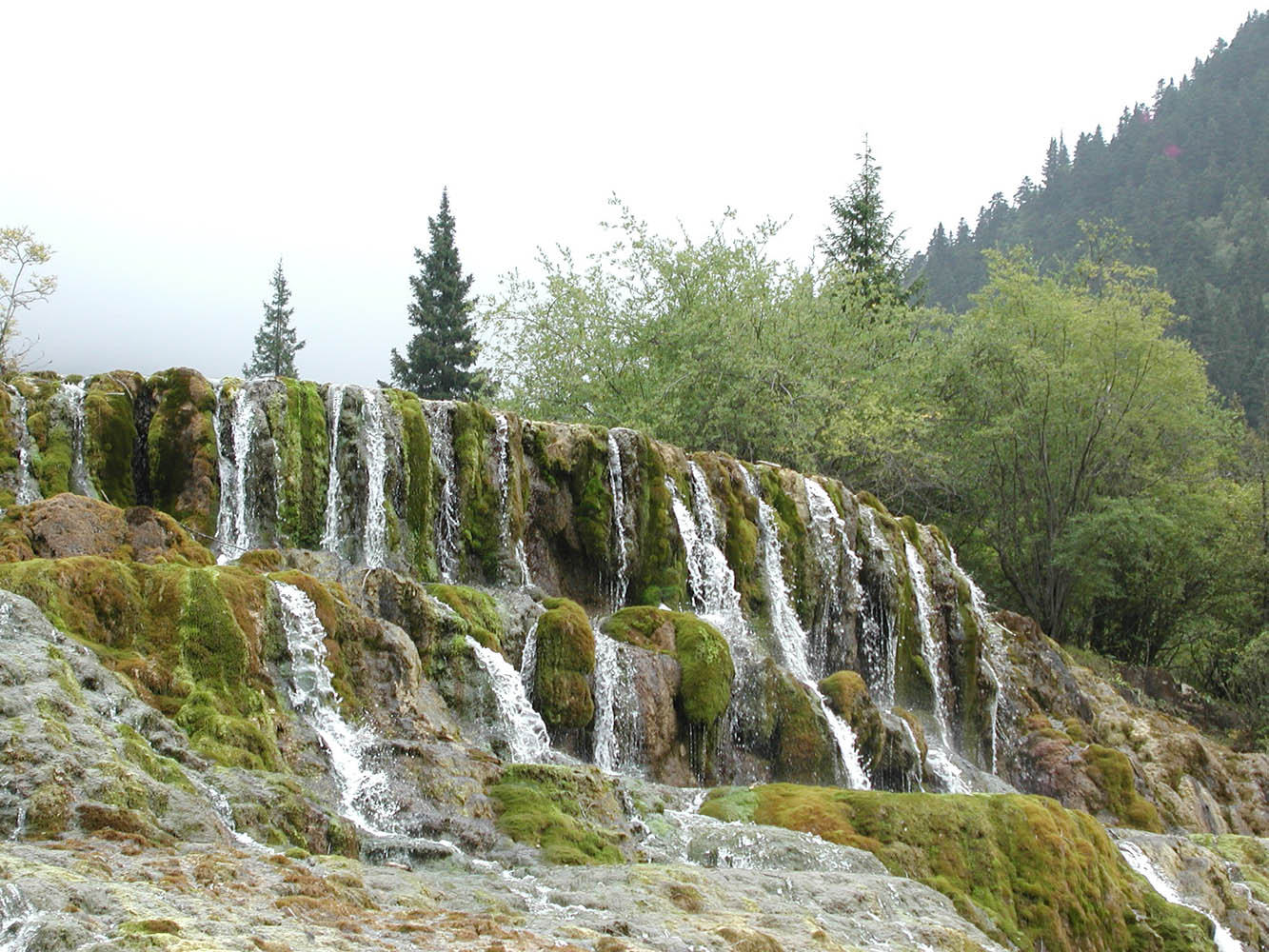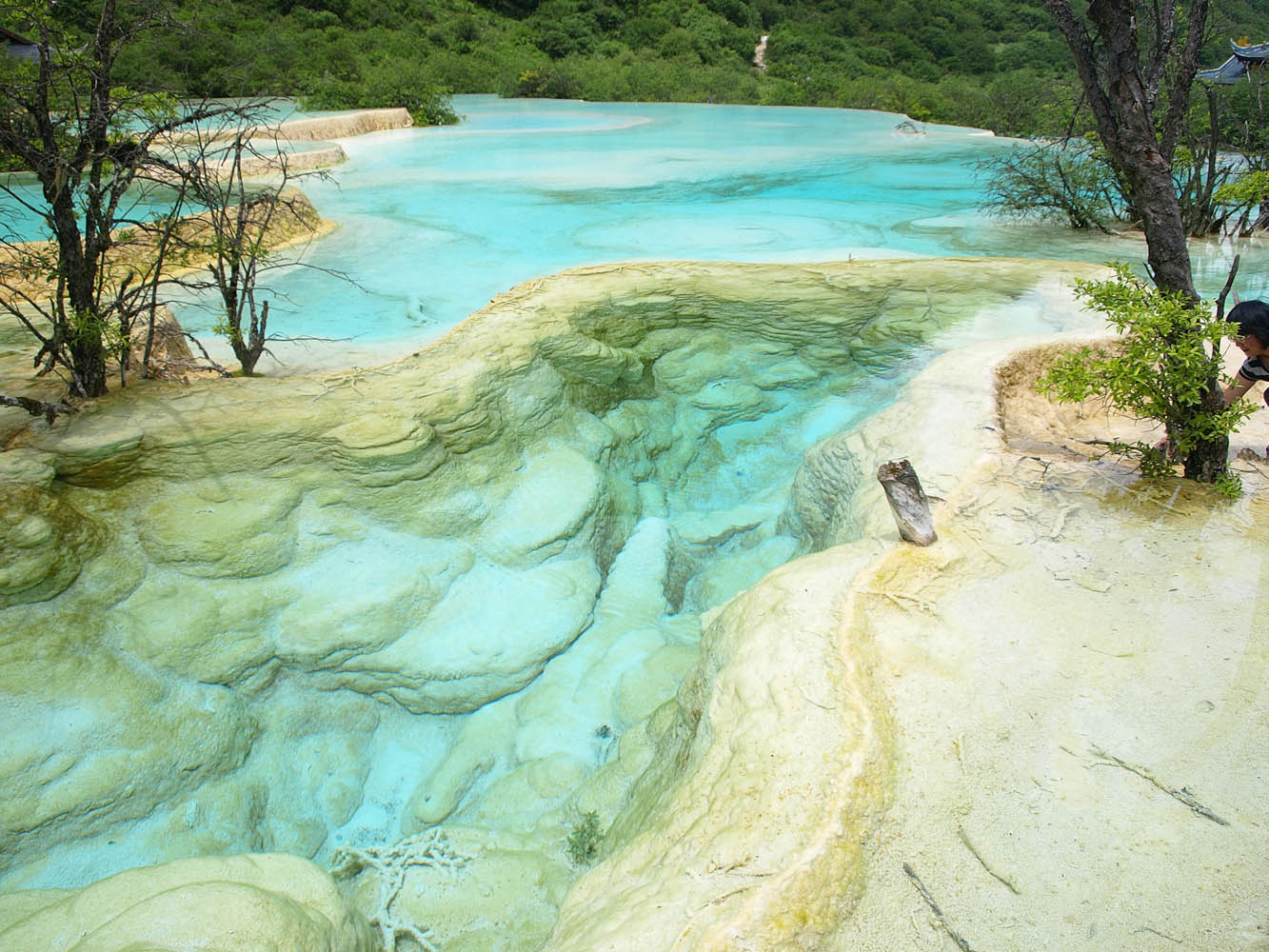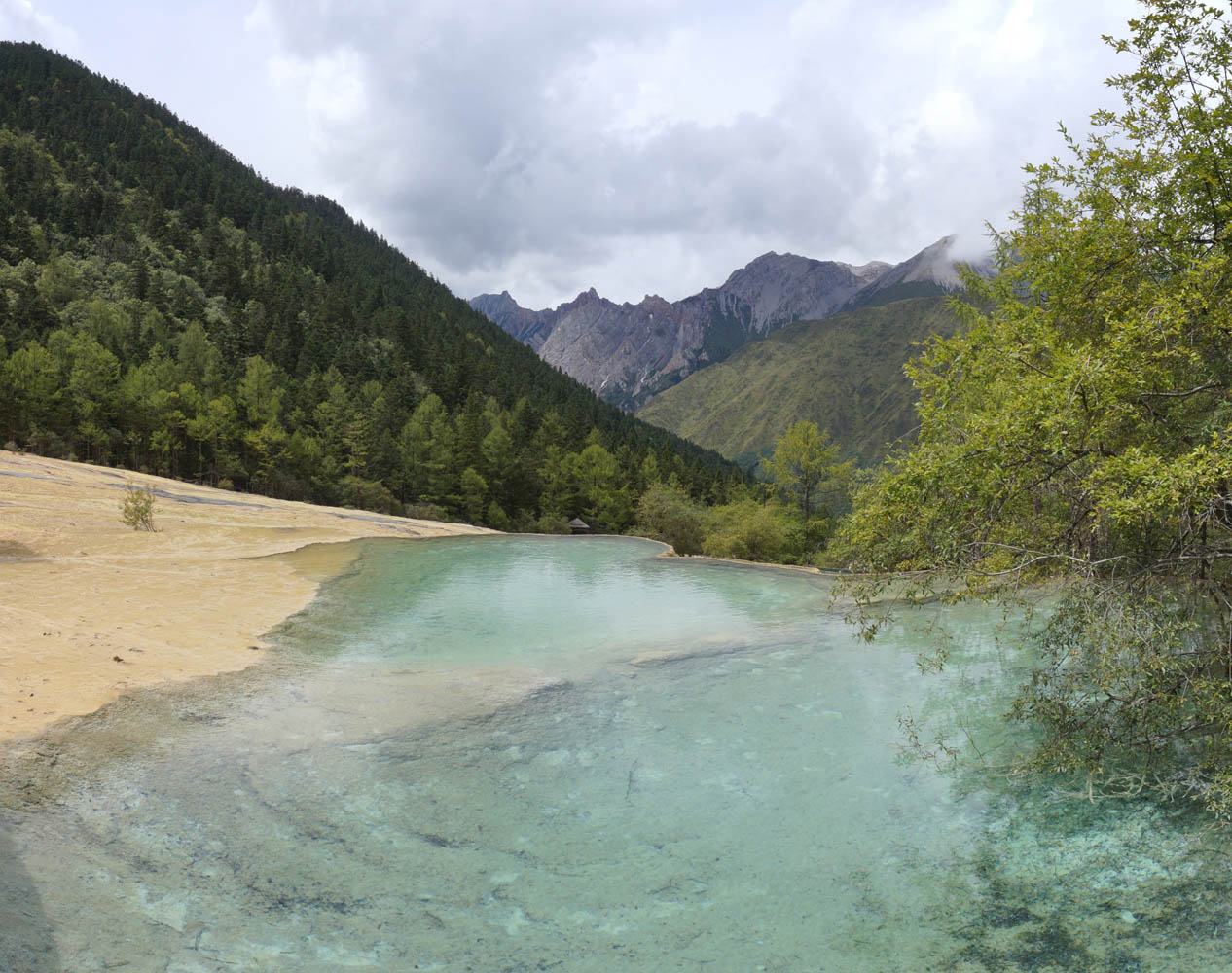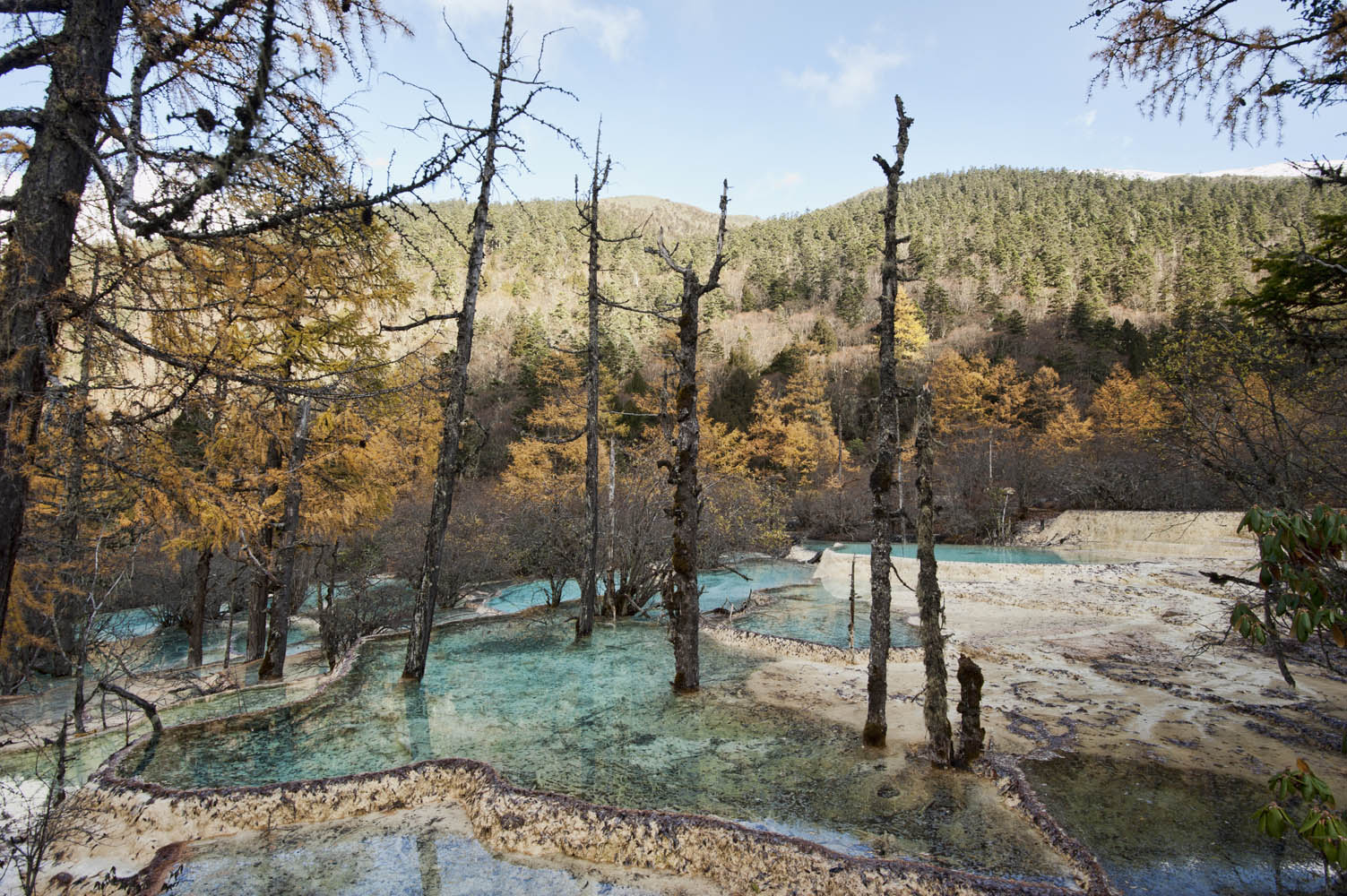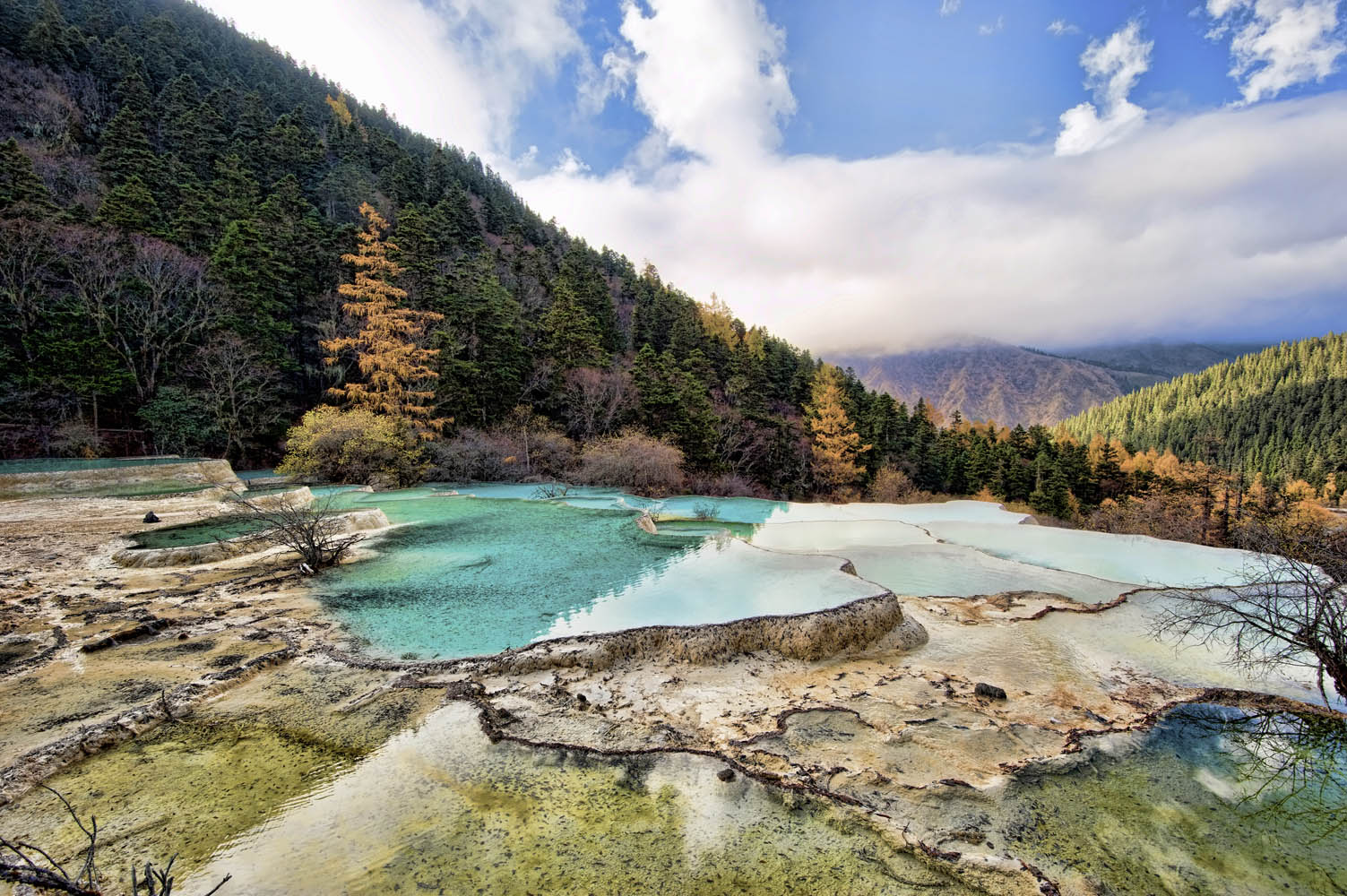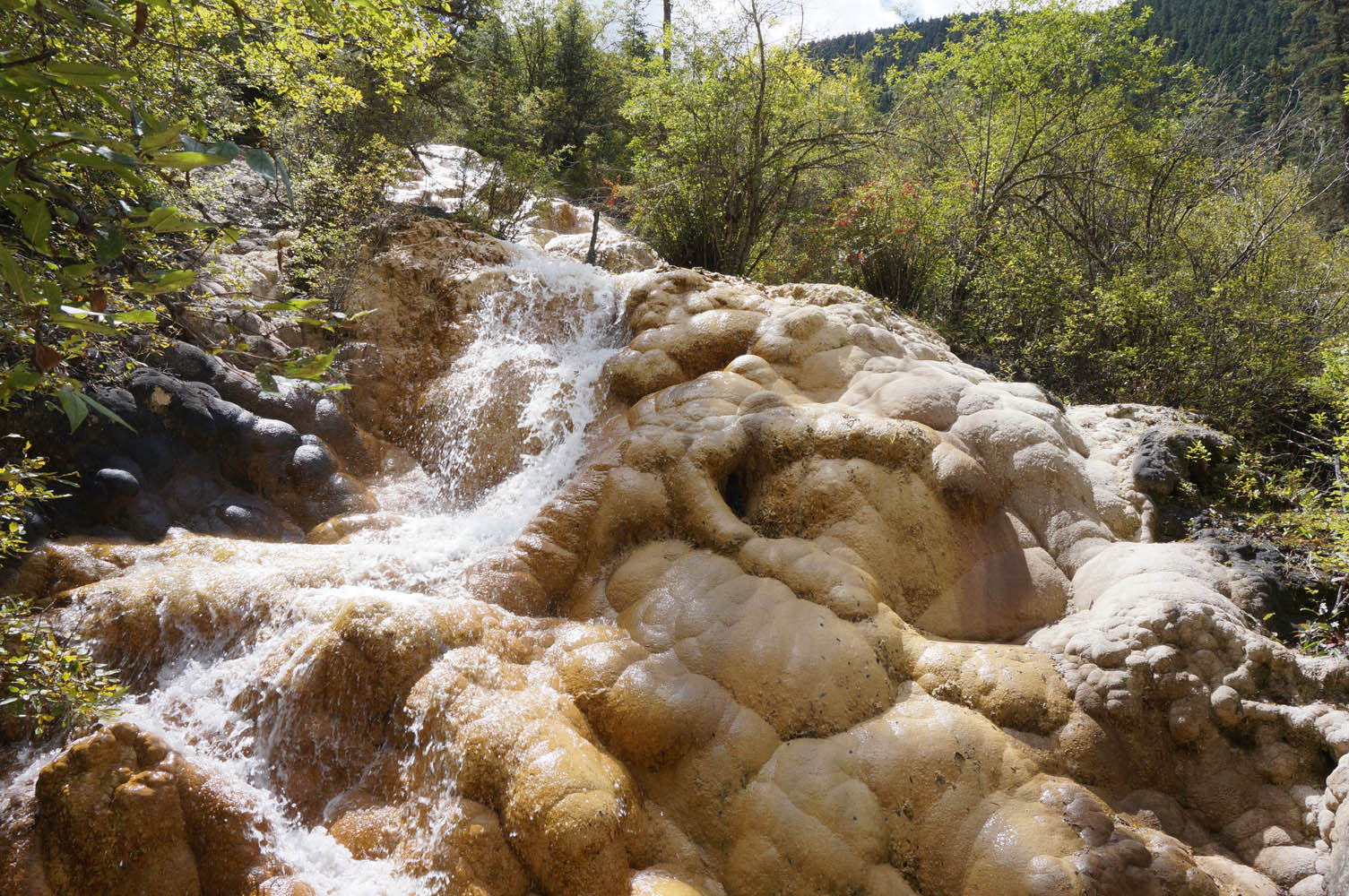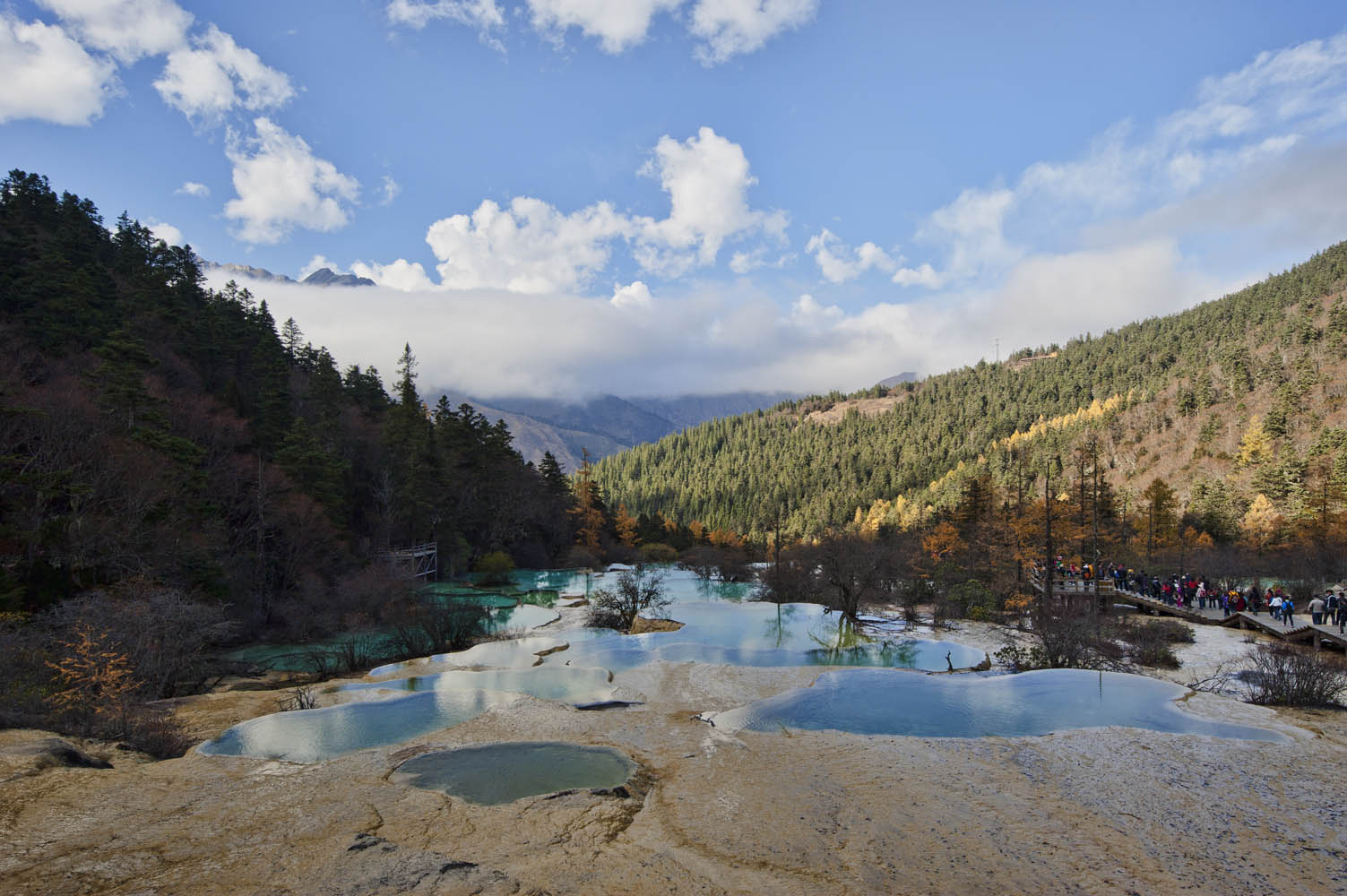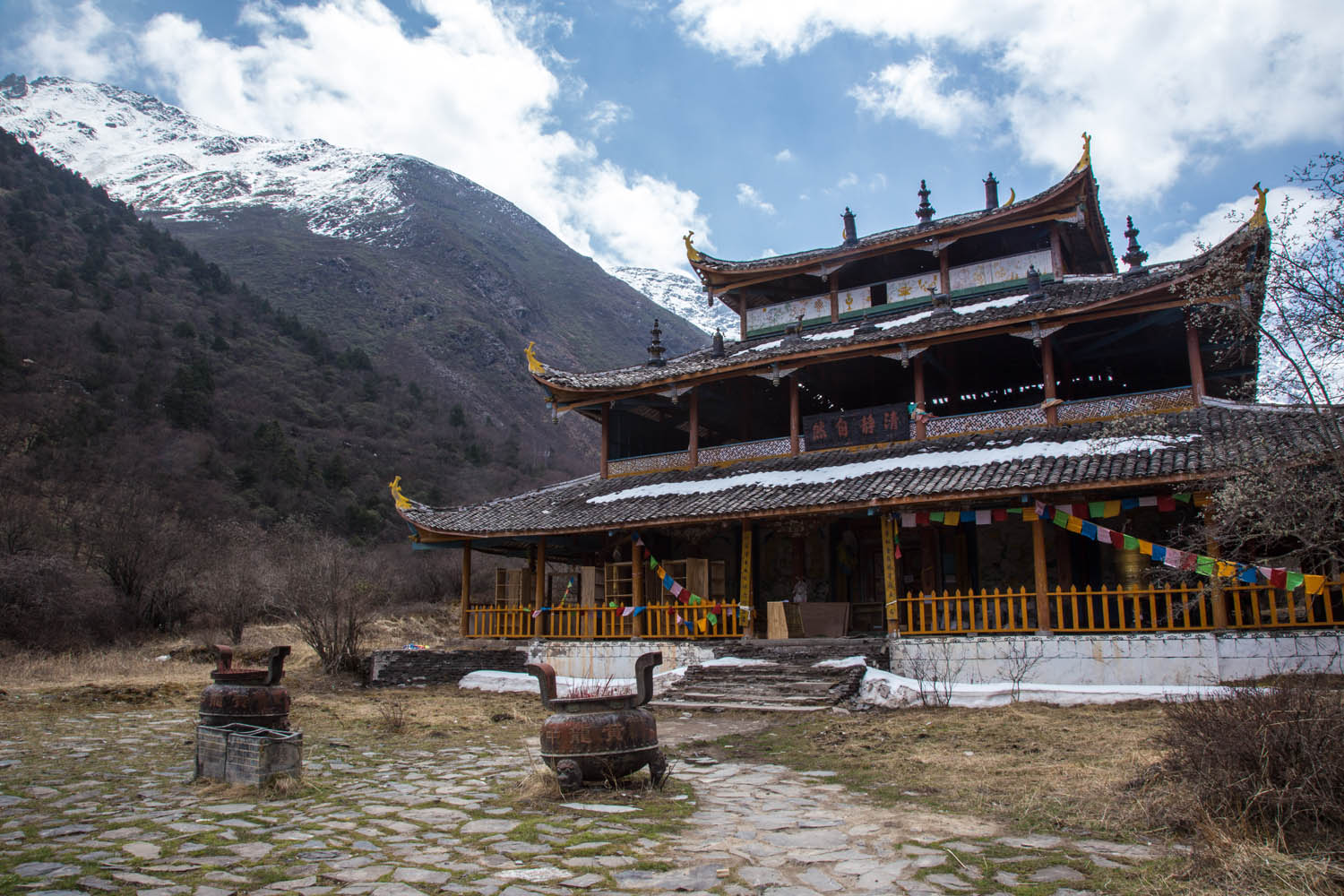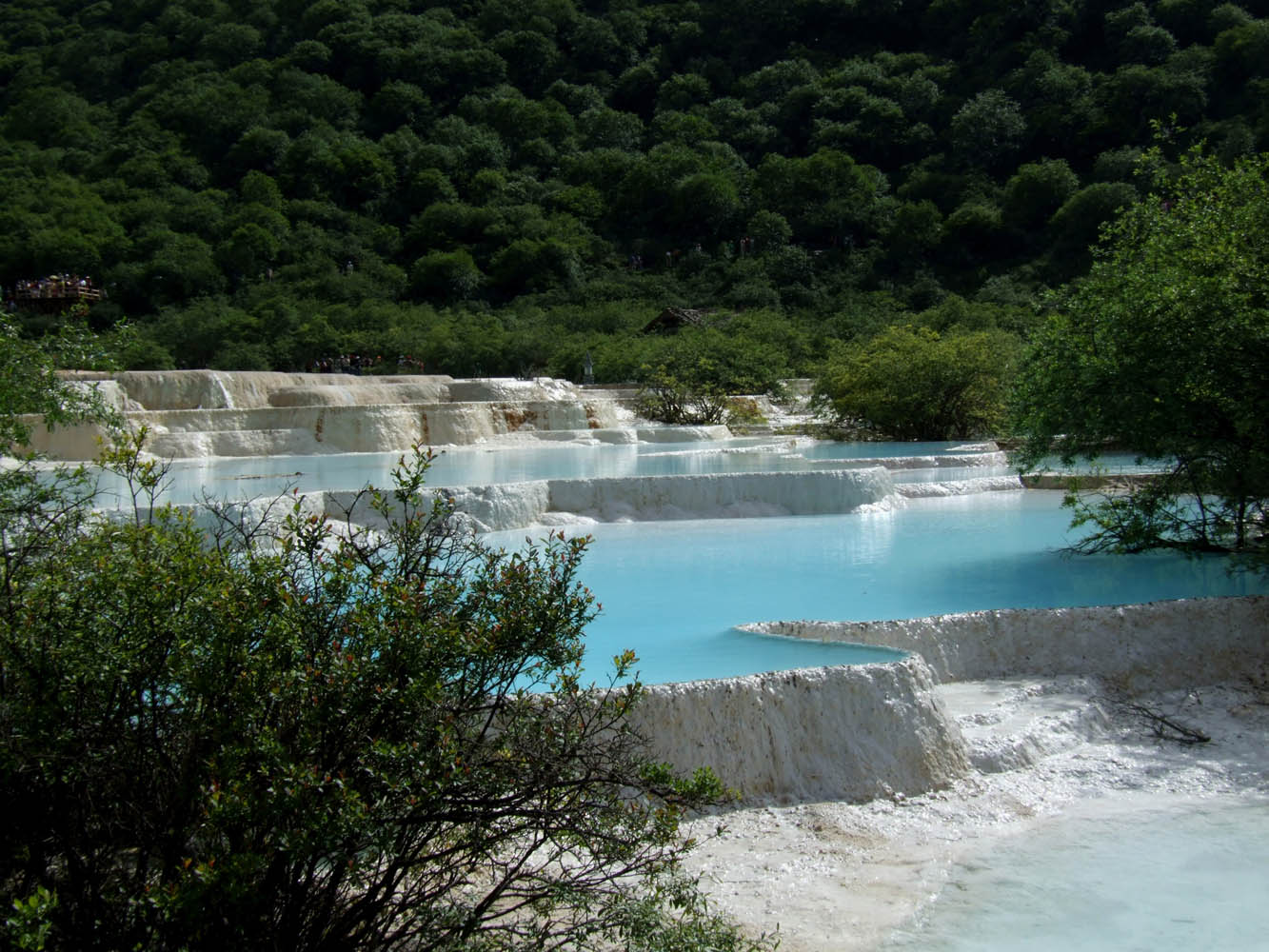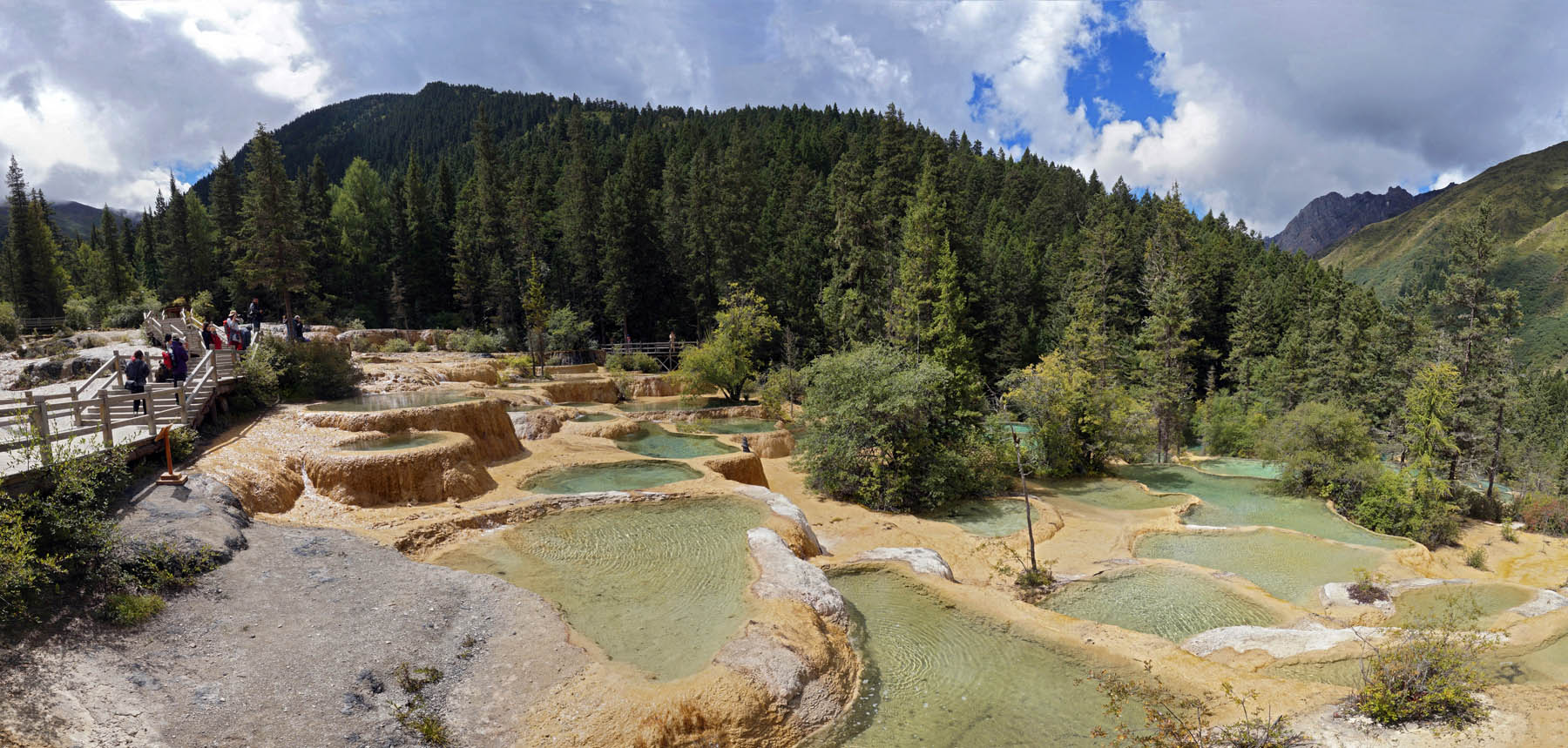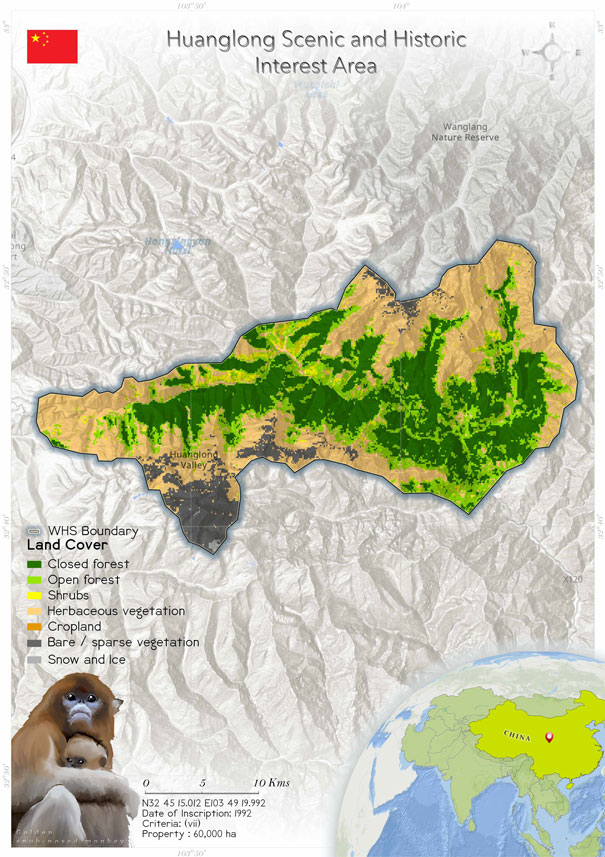
Huanglong Scenic and Historic Interest Area (638)
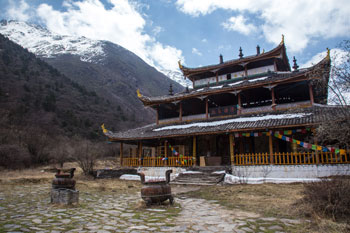 The Huanglong Scenic and Historic Interest Area lies within the southern part of the Minshan Mountain Range. The property was designated a biosphere reserve in 2000, under the UNESCO’s MAB programme. The mountainous landscape is famous for its travertine formations, colourful and continuous pools, waterfalls and shoals. The main sources of water of the waterfalls and pools are groundwater, snow melt and rainwater. The site is an aggregation of multiple spectacular landscapes, but the prime tourist attraction is the scenically mesmerizing Huanglong Valley. The valley is of religious important not only to local people but also people from neighbouring regions. The Huanglong Scenic and Historic Interest Area also hosts a spectacular diversity of animals and plants. The site is home to the giant panda (Ailuropoda melanoleuca), golden monkey (Rhinopithecus roxellana) and globally threatened plant species such as Pterostylax psilophyllus (VU), Larix mastersiana (VU), Picea brachytyla (VU), Magnolia officinalis. The rise of Tibet against China harmed the scenic area. The three temples in Huanglong Valley suffered a lot for centuries, but during the 1980s, the middle and rear temples were restored, and the pilgrimage to the valley restarted. The Huanglong administration has been applauded for its ecotourism management and for conserving the Outstanding Universal Value. The IUCN outlook assessment also shows that the site does not have any immediate concerns.
The Huanglong Scenic and Historic Interest Area lies within the southern part of the Minshan Mountain Range. The property was designated a biosphere reserve in 2000, under the UNESCO’s MAB programme. The mountainous landscape is famous for its travertine formations, colourful and continuous pools, waterfalls and shoals. The main sources of water of the waterfalls and pools are groundwater, snow melt and rainwater. The site is an aggregation of multiple spectacular landscapes, but the prime tourist attraction is the scenically mesmerizing Huanglong Valley. The valley is of religious important not only to local people but also people from neighbouring regions. The Huanglong Scenic and Historic Interest Area also hosts a spectacular diversity of animals and plants. The site is home to the giant panda (Ailuropoda melanoleuca), golden monkey (Rhinopithecus roxellana) and globally threatened plant species such as Pterostylax psilophyllus (VU), Larix mastersiana (VU), Picea brachytyla (VU), Magnolia officinalis. The rise of Tibet against China harmed the scenic area. The three temples in Huanglong Valley suffered a lot for centuries, but during the 1980s, the middle and rear temples were restored, and the pilgrimage to the valley restarted. The Huanglong administration has been applauded for its ecotourism management and for conserving the Outstanding Universal Value. The IUCN outlook assessment also shows that the site does not have any immediate concerns.
 Huanglong Scenic & Historic Interest Area is situated in the Min Shan Range, in the north-western part of China’s Sichuan Province. It is located at 32? 45' 15'' N, 103? 49' 20'' E (Yu et al. 2019). The property is a cluster of many exciting areas, including Huanglong Valley, Danyun Gorge, Mouni Valley, Xuebao Peak, Snow Mountain Ridge, Hongxin Rock and Western Valley (Huangdong 2013). It was inscribed as a World Heritage Site in 1992. The property has a total area of 60,000 ha and a buffer area of 58,000 ha. This scenic area is famous for its beautifully coloured ponds, waterfalls, limestone formations and snow-capped peaks. It also has a unique and diverse forest ecosystem. The mountains of Huanglong Scenic and Historic Interest Area rise 1700–5588 m and are permanently covered in snow. Huanglong Valley is the main scenic attraction of the site. The primary source of the surface stream of Huanglong Valley is groundwater, snowmelt and rainwater. Huanglong Valley, also known as “Yellow Dragon”, is named so in Chinese because of the ochre coloured deposition produced by cyanobacteria (Yoshimura et al. 2004). The streams, waterfalls, pools and shoals of Huanglong are dominated by psychrophilic diatoms: Cymbella cymbiformis and Cymbella gracilis. These diatoms play an essential and positive role. They precipitate travertine from slow-flowing water at low temperatures (Sun et al. 2014). This World Heritage Site is well known for possessing a diverse landscape and some of the rarest faunal species. These include the giant panda (Ailuropoda melanoleuca), golden monkey (Rhinopithecus roxellana), takin (Budorcas taxicolor), lesser panda (Ailurus fulgens), Chinese leopard (Panthera pardus fusca) and many birds (Prener 2005). Melissa Songer, in her article “Modeling Impacts of Climate Change on Giant Panda Habitat”, reports that more than 40% of the giant panda population is supported by the Minshan Mountains, making them the largest habitat suitable for the species. Apart from this incredible faunal diversity, the site is also rich in floral species. The flora of Huanglong is mainly dominated by orchids. The astonishing variety of orchids includes epiphytic species, such as Phalaenopsis wilsonii and Neofinetia falcata, and terrestrial ones, such as Cymbidium spp., Calanthe spp., Amitostigma spp. and Goodyera spp. (Prener 2005). Huanglong is at the intersection of four floristic regions, i.e., Eastern Asia, the Himalaya and the sub-tropical and tropical Palaearctic zones. 65.8% of the heritage site has forest cover, and some of the area is used by local pastoralists for agriculture. The forest is a mixture of Chinese hemlock (Tsuga chinensis), pines, maples and arrow bamboo. The forest is also dominated by firs, spruce (Picea asperata, P. purpurea and P. wilsonii), larch and birches.
Huanglong Valley is a tourist attraction and an old multiethnic pilgrimage destination of Buddhists, Tibetans and Daoists. The valley has three temples, the Front Temple, the Middle Temple and the Rear Temple. situated at altitudes from the foot of Minshan Mountain to the top. The pilgrims ultimate destination is the Rear Temple, also known as Huanglongsi (Temple of the Yellow Dragon) (Kang et al. 2009). The pilgrimage is made on the 15th of every sixth month. The Fan men and women wear colourful dresses. They carry beautiful coloured blankets and huge umbrellas during the festival. People can be seen dancing, singing and enjoying themselves during this temple fair (Kang et al. 2016).
Huanglong Scenic & Historic Interest Area is situated in the Min Shan Range, in the north-western part of China’s Sichuan Province. It is located at 32? 45' 15'' N, 103? 49' 20'' E (Yu et al. 2019). The property is a cluster of many exciting areas, including Huanglong Valley, Danyun Gorge, Mouni Valley, Xuebao Peak, Snow Mountain Ridge, Hongxin Rock and Western Valley (Huangdong 2013). It was inscribed as a World Heritage Site in 1992. The property has a total area of 60,000 ha and a buffer area of 58,000 ha. This scenic area is famous for its beautifully coloured ponds, waterfalls, limestone formations and snow-capped peaks. It also has a unique and diverse forest ecosystem. The mountains of Huanglong Scenic and Historic Interest Area rise 1700–5588 m and are permanently covered in snow. Huanglong Valley is the main scenic attraction of the site. The primary source of the surface stream of Huanglong Valley is groundwater, snowmelt and rainwater. Huanglong Valley, also known as “Yellow Dragon”, is named so in Chinese because of the ochre coloured deposition produced by cyanobacteria (Yoshimura et al. 2004). The streams, waterfalls, pools and shoals of Huanglong are dominated by psychrophilic diatoms: Cymbella cymbiformis and Cymbella gracilis. These diatoms play an essential and positive role. They precipitate travertine from slow-flowing water at low temperatures (Sun et al. 2014). This World Heritage Site is well known for possessing a diverse landscape and some of the rarest faunal species. These include the giant panda (Ailuropoda melanoleuca), golden monkey (Rhinopithecus roxellana), takin (Budorcas taxicolor), lesser panda (Ailurus fulgens), Chinese leopard (Panthera pardus fusca) and many birds (Prener 2005). Melissa Songer, in her article “Modeling Impacts of Climate Change on Giant Panda Habitat”, reports that more than 40% of the giant panda population is supported by the Minshan Mountains, making them the largest habitat suitable for the species. Apart from this incredible faunal diversity, the site is also rich in floral species. The flora of Huanglong is mainly dominated by orchids. The astonishing variety of orchids includes epiphytic species, such as Phalaenopsis wilsonii and Neofinetia falcata, and terrestrial ones, such as Cymbidium spp., Calanthe spp., Amitostigma spp. and Goodyera spp. (Prener 2005). Huanglong is at the intersection of four floristic regions, i.e., Eastern Asia, the Himalaya and the sub-tropical and tropical Palaearctic zones. 65.8% of the heritage site has forest cover, and some of the area is used by local pastoralists for agriculture. The forest is a mixture of Chinese hemlock (Tsuga chinensis), pines, maples and arrow bamboo. The forest is also dominated by firs, spruce (Picea asperata, P. purpurea and P. wilsonii), larch and birches.
Huanglong Valley is a tourist attraction and an old multiethnic pilgrimage destination of Buddhists, Tibetans and Daoists. The valley has three temples, the Front Temple, the Middle Temple and the Rear Temple. situated at altitudes from the foot of Minshan Mountain to the top. The pilgrims ultimate destination is the Rear Temple, also known as Huanglongsi (Temple of the Yellow Dragon) (Kang et al. 2009). The pilgrimage is made on the 15th of every sixth month. The Fan men and women wear colourful dresses. They carry beautiful coloured blankets and huge umbrellas during the festival. People can be seen dancing, singing and enjoying themselves during this temple fair (Kang et al. 2016).
Criterion (vii)
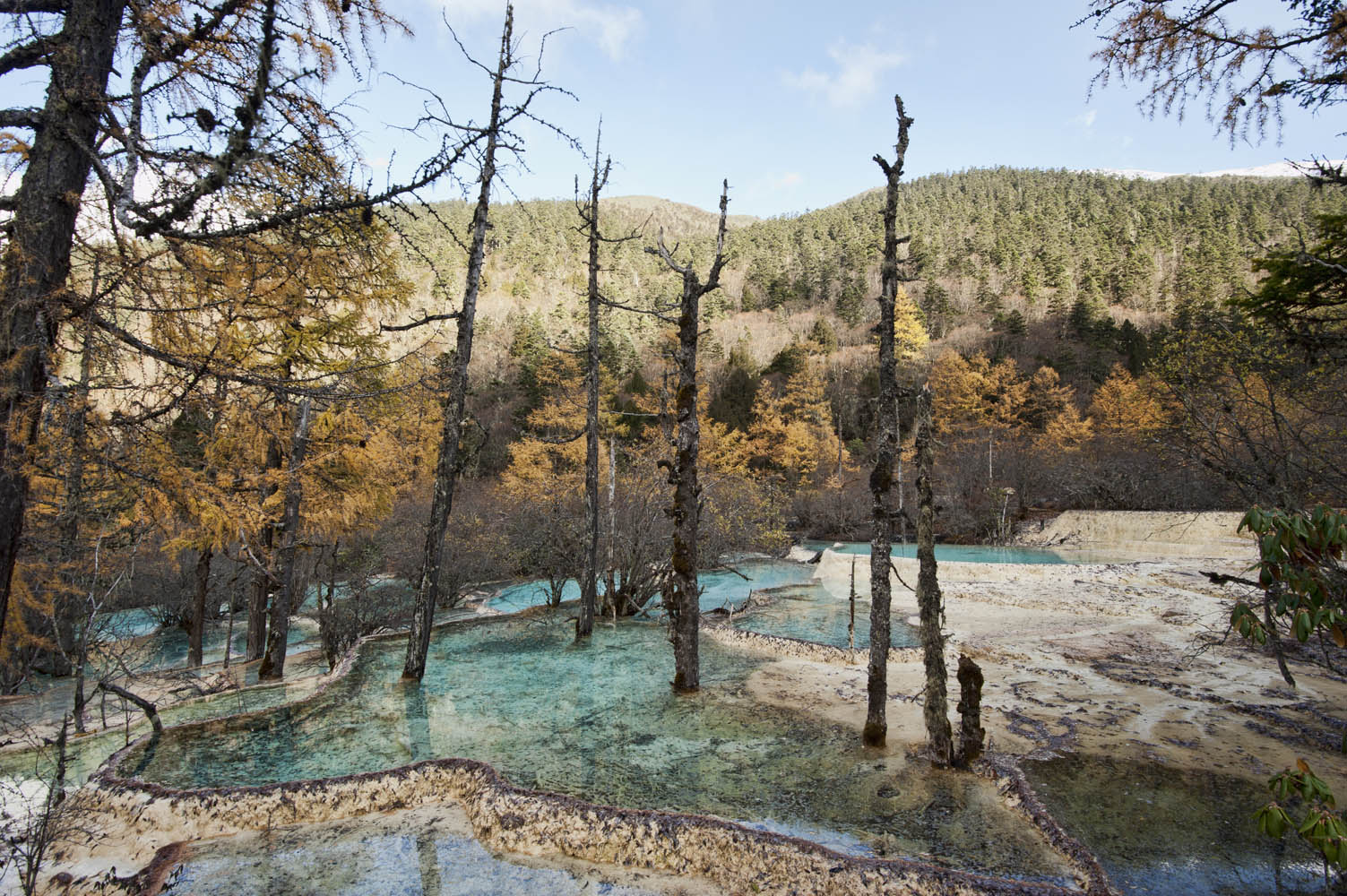 Huanglong is renowned for its beautiful mountainous scenery, with relatively undisturbed and highly diverse forest ecosystems, combined with the more spectacular localised karst formations, such as travertine pools, waterfalls and limestone shoals. Its travertine terraces and lakes are certainly unique in all of Asia, and rate among the three most outstanding examples in the world.
Huanglong is renowned for its beautiful mountainous scenery, with relatively undisturbed and highly diverse forest ecosystems, combined with the more spectacular localised karst formations, such as travertine pools, waterfalls and limestone shoals. Its travertine terraces and lakes are certainly unique in all of Asia, and rate among the three most outstanding examples in the world.
Status
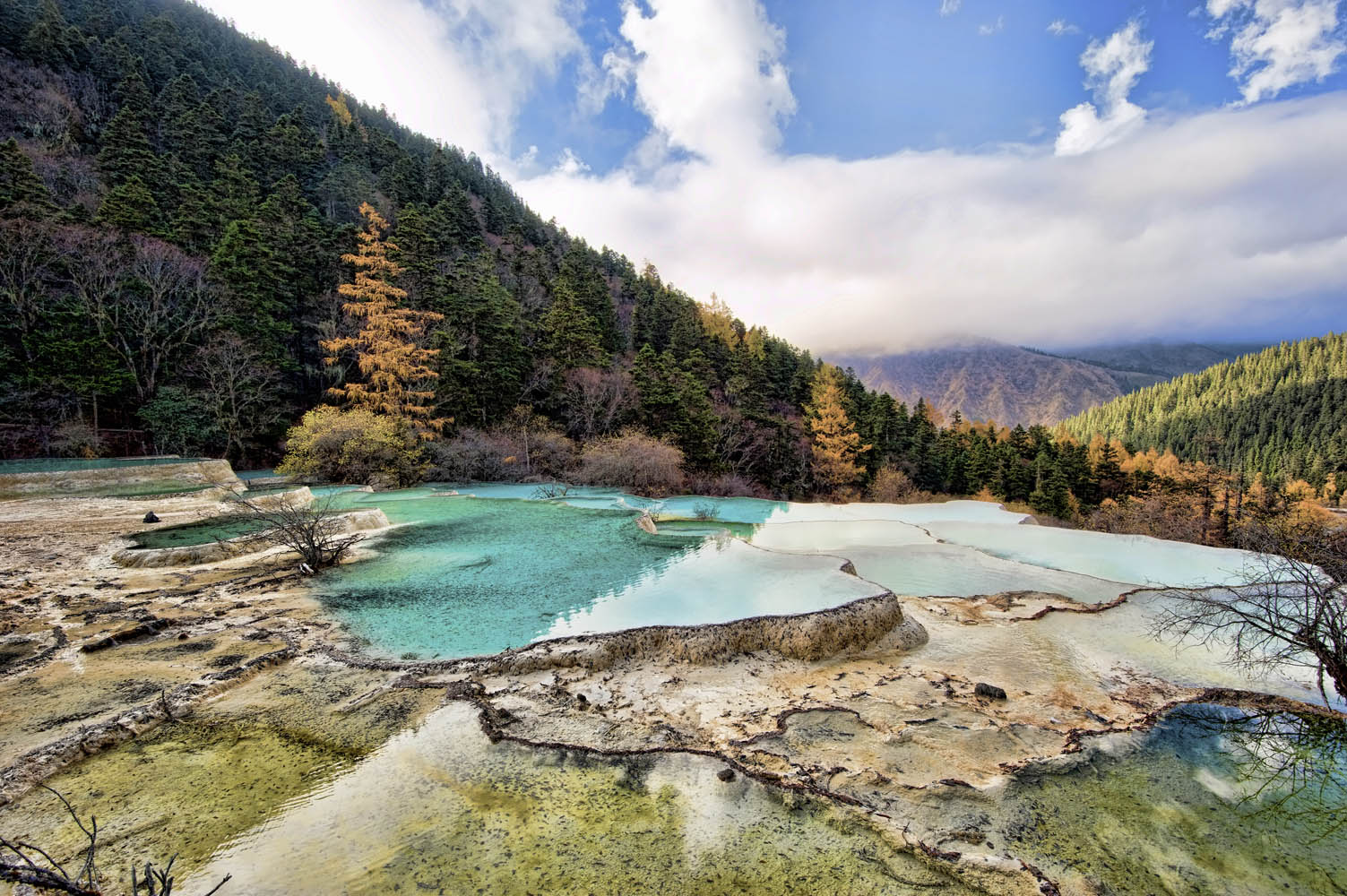 In 1982, Huanglong was declared the national scenic zone for its beautiful multi-coloured pools, travertine formations and spectacular karst formations. The temples of Huanglong were damaged during the uprising of Tibet in 1911. The Front Temple has not been restored, but the Middle and Rear temples have been rebuilt. In the 1960s and 1970s, religious activities were deemed illegal, and temples and monasteries were demolished. Those that were not demolished were converted into public facilities. During these years, Huanglong suffered severely. The 1980s were good times for Huanglong as religion was revived again by the locals and tourism also started thriving. These two developments took place independently. The site management emphasized the natural appeal of Huanglong although there is a cultural aspect to the site. Moreover, in 1992, the Huanglong Scenic and Historic Area was inscribed as a natural World Heritage Site of UNESCO. In 1997, the site management was also asked to re-inscribe the site as a cultural World Heritage Site, but they rejected the proposal. Huanglong’s outstanding universal value lies in the site being the “most important and significant natural habitats for in situ conservation of biological diversity”.
The assessment of IUCN World Heritage Outlook (2020) (Huanglong Scenic and Historic Interest Area World Heritage Outlook (iucn.org) shows that there are no significant concerns about the overall management of the administration and that the site does not face any significant threats. The scenic and aesthetic values of the natural heritage site are intact. However, natural disasters and catastrophes are an issue of concern, and the management needs to adopt proper disaster management policies. The increase in tourism might be of concern along with the weak biodiversity protection and management policies. Overall, it could be said that the management of the Huanglong administration is effective. The inscription of the Huanglong Scenic and Historic Interest Area in the UNESCO World Heritage Site list has significantly impacted the conservation of the site’s Outstanding Universal Value. It was after the inscription that the temples and other associated infrastructure of the natural site were restored.
In 1982, Huanglong was declared the national scenic zone for its beautiful multi-coloured pools, travertine formations and spectacular karst formations. The temples of Huanglong were damaged during the uprising of Tibet in 1911. The Front Temple has not been restored, but the Middle and Rear temples have been rebuilt. In the 1960s and 1970s, religious activities were deemed illegal, and temples and monasteries were demolished. Those that were not demolished were converted into public facilities. During these years, Huanglong suffered severely. The 1980s were good times for Huanglong as religion was revived again by the locals and tourism also started thriving. These two developments took place independently. The site management emphasized the natural appeal of Huanglong although there is a cultural aspect to the site. Moreover, in 1992, the Huanglong Scenic and Historic Area was inscribed as a natural World Heritage Site of UNESCO. In 1997, the site management was also asked to re-inscribe the site as a cultural World Heritage Site, but they rejected the proposal. Huanglong’s outstanding universal value lies in the site being the “most important and significant natural habitats for in situ conservation of biological diversity”.
The assessment of IUCN World Heritage Outlook (2020) (Huanglong Scenic and Historic Interest Area World Heritage Outlook (iucn.org) shows that there are no significant concerns about the overall management of the administration and that the site does not face any significant threats. The scenic and aesthetic values of the natural heritage site are intact. However, natural disasters and catastrophes are an issue of concern, and the management needs to adopt proper disaster management policies. The increase in tourism might be of concern along with the weak biodiversity protection and management policies. Overall, it could be said that the management of the Huanglong administration is effective. The inscription of the Huanglong Scenic and Historic Interest Area in the UNESCO World Heritage Site list has significantly impacted the conservation of the site’s Outstanding Universal Value. It was after the inscription that the temples and other associated infrastructure of the natural site were restored.
